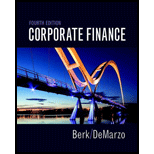
To Determine: The risk a default-risk free bond investor faces when the individual needs to sell the bonds before the maturity date.
Introduction:
A yield to maturity (YTM) is the
A coupon payment is the yearly interest payment that is remunerated to a bondholder by the issuer of the bond until the point that the debt obligation matures. The coupon payments are cyclic payments of interest offered to the bondholders. Default-free bonds do not have any default risk. A common example of default-free bonds is U.S government bonds.
Want to see the full answer?
Check out a sample textbook solution
Chapter 6 Solutions
Corporate Finance (4th Edition) (Pearson Series in Finance) - Standalone book
- How is a bond’s duration impacted by varying the coupon rate? How is a bond’s duration impacted by varying the time to maturity? What implications would these impacts have for a bond investor if interest rates change?arrow_forwardHow do interest rates affect bond valuations? What are the key assumptions in valuing a bond?arrow_forwardWhat impact do interest rates have on bond prices? What are the fundamental assumptions that go into valuing a bond?arrow_forward
- What economic circumstances might encourage investors to use a bond's convertibility feature?arrow_forwardWhat effect do interest rates have on bond prices? What are the underlying assumptions that go into determining the value of a bond?arrow_forwardHow does one determine the required rate of return of a bond, the cash flows of a bond and the value of a bond? How do you determine if a bond is a good investment? Are long-term bonds riskier than short-term bonds? Explain and Discuss.arrow_forward
- What impact do interest rates have on bond prices? What are the basic assumptions that go into determining a bond's value?arrow_forwardWhat is a bond spread and how is it related tothe default risk premium? How are bond ratingsrelated to default risk? What factors affect a company’s bond rating?arrow_forwardWhat impact do interest rates have on bond prices? What are the key assumptions that go into determining the value of a bond?arrow_forward
- Does interest rate risk matter or is it negligible? Why/why not? Will it be important for one who is holding their bond for maturity?arrow_forwardIs the price of a long-term (longer-maturity) bond more or less sensitive to changes in interest rates than that of a short-term bond? Why?arrow_forwardWhat is the “call” feature of a bond issue? How does thecall feature affect the amortization of bond premium ordiscount?arrow_forward
 Intermediate Financial Management (MindTap Course...FinanceISBN:9781337395083Author:Eugene F. Brigham, Phillip R. DavesPublisher:Cengage Learning
Intermediate Financial Management (MindTap Course...FinanceISBN:9781337395083Author:Eugene F. Brigham, Phillip R. DavesPublisher:Cengage Learning
